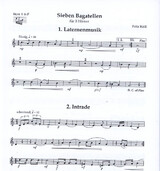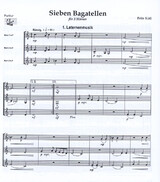 Loosmann MusikverlagStil:
Loosmann MusikverlagStil:  RomantikAusgabe: NotenArt-Nr.: D2281 / E0351
RomantikAusgabe: NotenArt-Nr.: D2281 / E0351
Sätze:
1. Laternenmusik, 2. Intrade, 3. Ballabile, 4. Hornruf,
5. Alla Marcia, 6. Berceuse, 7. Hatz (Caccia).
Vorwort
Bei den SIEBEN BAGATELLEN für drei Hörner kommt der Leitgedanke für die Kompositionsweise Fritz Kölls besonders deutlich zum Ausdruck: mit einfachen Mitteln Hintergründiges darzustellen. Köll versteht es, mit eingeschränkten technischen Anforderungen die Mittellage des Horns auszureizen und damit gleichzeitig anspruchsvolle als auch für Schüler und Liebhaber spielbare Musik
zu schaffen. Die Laternenmusik zu Beginn vermittelt eine lebendige Vorstellung
von Nachtwächter-Rufen. Die Intrade kündigt mit Signal und Fanfarenstößen den würdevollen Einzug hoher Gäste an, gefolgt von einem Ballabile, das an einen höfischen Tanz, ein Menuett erinnert. Der nächste Satz, Hornruf, weckt Gedanken an ein schlichtes, jedoch inniges Dankgebet. Daran schließt mit Alla Marcia ein fröhlicher Marsch mit ruhigem, kantablen Trio und Da Capo an.
Eine freundlich wiegende Berceuse folgt, und eine temperamentvolle und ausgelassene Hatz (caccia) bildet den Schlusssatz.
Albert Schwarzmann
Preface
In the SIEBEN BAGATELLEN for three horns, Fritz Koells philosophy for composing is expressed especially clearly: to interpret the background with simple means. Without placing too many technical demands on the player, Köll knows exactly how to draw everything out of the middle range of the horn, thereby creating music that is sophisticated yet can be played by pupils and music lovers. The Laternenmusik at the beginning conveys a vivid image the night watchman calling on his horn. The Intrade announces the dignified arrival of esteemed guests with signals and bursts of fanfare. This, in turn, is followed by a Ballabile, which is suggestive of
the minuet, a courtly dance. The next movement, Hornruf, calls forth images of a simple but devout thanksgiving prayer. Subsequent to that is Alla Marcia, a merry march with quiet, cantabile trio and da capo. After that comes pleasantly swaying Berceuse. As the final movement there is a high-spirited and boisterous Hatz (caccia).
Translation by Alexander Biewald







